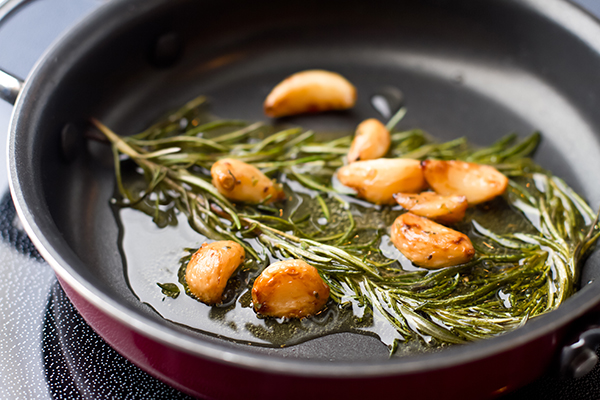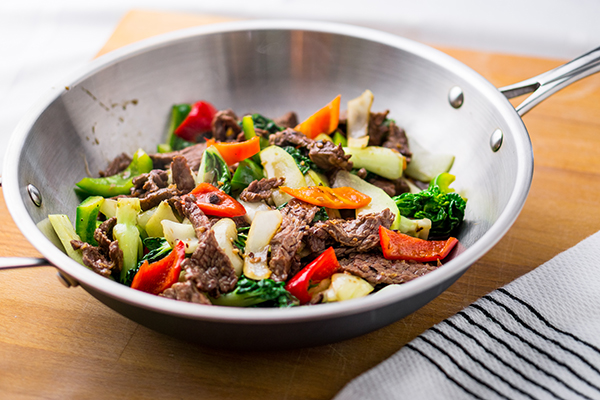The Ultimate Guide to Cooking Oils

Flaxseed, walnut, olive, peanut, avocado — with so many types of cooking oil on supermarket shelves, how do you know which one you should choose for your sautés and stir-fries?
To help you make sense of the options, we’ve put together a straightforward guide to the various types of cooking oil — so you’ll know exactly which oil to grab the next time you’re working your kitchen magic.
The Healthiest Types of Cooking Oil
First things first: All cooking oils are high in calories and fat, delivering about 120 calories and 14 grams of fat per tablespoon.
However, they differ in their balance of saturated fat, monounsaturated fats (MUFAs), and polyunsaturated fats (PUFAs).
MUFAs and PUFAs are both considered healthy fats.
(Omega-3 and omega-6 fatty acids are polyunsaturated fats, while omega-9 fatty acids are monounsaturated fats.)
However, research suggests monounsaturated fats, in particular, may support heart health, so MUFA-rich oils will likely be your healthiest option — though moderation is still key.

Here are the top options:
Avocado Oil
Avocado oil boasts both vitamin E and heart-healthy phytosterols, says Elle Penner, R.D. Around 71 percent of its fat content comes from MUFAs.
Avocado oil has a high smoke point, which makes it a great option for high-heat cooking, like stir-frying and searing meat — but it also works well in salad dressings, dips, and marinades.
Extra Virgin Olive Oil
A tablespoon of extra virgin olive oil contains 10 grams of monounsaturated fatty acids, or around 73 percent of the total fat content.
This is the healthiest option when it comes to olive oil, as it’s not refined.
Extra virgin olive oil has excellent flavor and a smoke point around 410 degrees °F, making it an excellent option for dressings or for moderate-heat cooking (such as a sauté).
Olive Oil
Like EVOO, regular olive oil has around 10 grams of MUFAs per tablespoon, along with vitamins E and K.
And with a slightly higher smoke point than extra virgin olive oil — typically around 420 degrees °F — it can hold up to high-heat cooking.
When choosing an olive oil, be aware that olive oils labeled “light” are light in color, not in calories.
Opt for “virgin” or “pure” olive oils, which are more refined and will tolerate more heat.

Healthy Types of Cooking Oil (in Moderation)
Avocado and olive oils are both MUFA-rich cooking oils with a mild flavor, making them healthy and versatile options.
However, you may be wondering how the other types of cooking oil stack up — especially if you’re working with a recipe that calls for a specific type of cooking oil.
Here’s the rundown.
Safflower Oil
Safflower oil is another good all-purpose cooking oil. Each tablespoon of safflower oil contains 10.5 grams of MUFAs (around 75 percent of its total fat content) and 1.8 grams of PUFAs, along with vitamin E.
With a smoke point between 450 and 510 degrees °F, it’s suitable for high-heat cooking, and its flavor pairs especially well with chicken and pasta dishes.

Peanut Oil
Each tablespoon of peanut oil has around 6.5 grams of MUFAs, 4.5 grams of PUFAs, and 2.4 grams of saturated fats, along with some vitamin E.
“Peanut oil is super-flavorful and good for high-heat cooking, especially for Asian stir-fry dishes and cooking and frying fish,” Penner says.
You can also use it for baking and sautés.
Almond Oil
Almond oil has 9.79 grams of MUFAs per tablespoon.
It’s also a source of omega-6 fatty acids, which may be beneficial for heart health — but they should be consumed in moderation and balanced with plenty of omega-3 fatty acids.
Almond oil has a high smoke point — around 430 degrees °F — that makes it suitable for high-heat cooking, and its distinct flavor also makes it great for enhancing desserts or drizzling over salads.
Sesame Oil
Sesame oil has a balance of monounsaturated and polyunsaturated fatty acids — around 5.5 grams of MUFAs and 5.8 grams of PUFAs per tablespoon.
Popular in Asian cuisines, full-flavored sesame oil has a smoke point between 350 and 450 degrees °F, making it suitable for low-heat cooking and sauces.
(Unrefined sesame oil is less heat-tolerant than semi-refined sesame oil.)
Keep it refrigerated, as it can oxidize.
Grapeseed Oil
Extracted from grape seeds, a tablespoon of grapeseed oil has 10 grams of MUFAs — about 73 percent of its fat content.
Its smoke point of 485 degrees °F makes it well-suited to oven cooking and sautés.
However, it goes rancid quickly, so make sure to store it in the refrigerator.
Coconut Oil
Coconut oil contains medium-chain triglycerides (MCTs) that may help to increase energy expenditure (the total number of calories you burn in a day).
However, it’s high in saturated fat — a tablespoon of coconut oil has 11.6 grams of saturated fats, or about 83 percent of its total fat content, so use it in moderation.
Coconut oil also has a relatively low smoke point of 350 degrees °F, so it’s best as a substitute for butter or shortening in low-heat baking, light sautéing, or sauces.
Use These Types of Cooking Oil Sparingly
A few types of cooking oil tend to go rancid quickly or have a low smoke point that makes them unsuitable for cooking.
Be mindful that the production methods of each type of cooking oil will also factor into the health equation.
Penner recommends choosing “cold-pressed” or “expeller-pressed” oils when possible. These can be pricier but yield a cleaner, purer, and more nutritionally-intact oil.

Flaxseed Oil
“Flaxseed oil is a great source of omega-3 fatty acids,” Penner says. One tablespoon of flaxseed oil has 2.58 grams of MUFAs and 9.5 grams of PUFAs.
However, because of its high concentration of alpha-linolenic acid (a PUFA), this seed-based oil doesn’t tolerate heat well.
Flaxseed oil oxidizes quickly and has a low smoke point, so keep it refrigerated and save it for salad dressings, dips, and marinades.
Walnut Oil
One of the most delicate oils, nutty-flavored walnut oil has a low smoke point and shouldn’t be heated.
It’s a great source of omega-3 fatty acids, says Penner, and is good in pesto or homemade salad dressing. Keep refrigerated.
Canola Oil
Canola oil is an all-purpose oil with 8.8 grams of MUFAs and 3.9 grams of PUFAs per tablespoon.
With a neutral flavor and smoke point of 400 degrees °F, it can be used for sautés, baking, browning, pan-frying, and stir-frying.
However, solvent-expelled oils, like canola oil, “tend to be highly refined, which negatively impacts nutritional quality,” Penner says.
They’re also extracted from the plant using chemicals, some of which may remain in the oil.
Soybean Oil
You’ll often find soybean oil under another name: Pure vegetable oil is often 100% soybean oil, which is cheap to produce and mostly made from soybeans that have been genetically modified.
A tablespoon of soybean oil has around 3.2 grams of MUFAs and 8 grams of PUFAs per serving, along with 2.2 grams of saturated fats.
With a smoke point of 450 degrees °F, soybean oil is suitable for baking, sautés, and sauces.
The Least Healthy Cooking Oil
“A diet that includes a variety of quality oils with saturated, monounsaturated, and polyunsaturated fats will offer the most nutrition and health benefits,” Penner says.
However, there’s one type of cooking oil you should ideally avoid:
Palm Oil
Palm oil is one of the most commonly used vegetable oils in the world, but the World Health Organization (WHO) notes that it may have a negative impact on overall health and the environment.
Palm oil’s high smoke point makes it suitable for frying, but Penner cautions that it’s “high in palmitic acid, which is associated with increased risk of heart disease.”
If you want to avoid it, check labels of packaged and processed foods, where it’s increasingly used as a replacement for artificial trans fats.
Smoke Point of Cooking Oils
In addition to nutrition and flavor, an oil’s smoke point — the temperature at which it starts to smoke and break down — helps determine whether you’ll use it for high-heat searing and frying, or save it for no-cook dressings and drizzling over finished dishes.
If your oil does start smoking, throw it out to avoid toxic fumes and byproducts.
| TYPES OF COOKING OIL | SMOKE POINT |
| Avocado oil (refined) | 520°F |
| Safflower oil | 450-510°F |
| Grapeseed oil | 485°F |
| Peanut oil (refined) | 450°F |
| Soybean oil | 450°F |
| Almond oil | 430°F |
| Canola oil | 400°F |
| Sesame oil | 350-450°F |
| Olive oil | 420°F |
| Extra virgin olive oil | 410°F |
| Coconut oil | 350°F |
| Walnut oil | 320-400°F |
| Flaxseed oil (refined) | 225°F |
Source: Culinary Nutrition: The Science and Practice of Healthy Cooking
Cooking Oil Storage Tips
Cooking oils are sensitive to light, air, and heat, so be sure to store them in cool, dark places such as a cupboard away from the stove.
Does your oil smell or taste bitter or otherwise “off”? Don’t try to stretch it — the nutrient value of oils decrease when they go rancid.
Delicate varieties — such as walnut, flaxseed, and grapeseed — go rancid more quickly and should be kept in the fridge.
